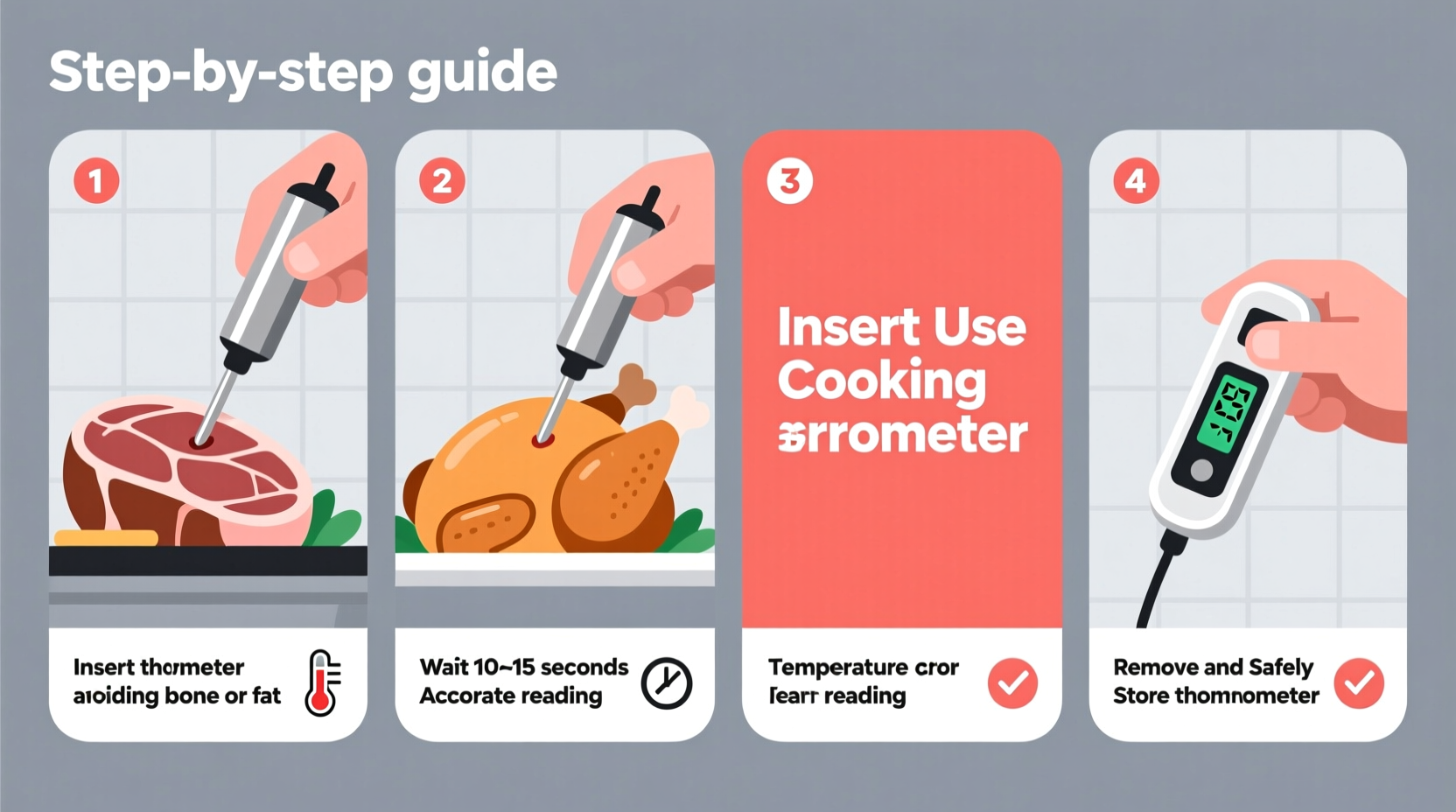Why Temperature Accuracy Matters More Than You Think
Food safety isn't just about cooking until "done"—it's about reaching specific internal temperatures that destroy harmful bacteria. According to the USDA Food Safety and Inspection Service, 1 in 6 Americans suffer from foodborne illness annually, with improper cooking temperatures being a leading cause. A quality cooking thermometer isn't optional kitchen equipment—it's your first line of defense against food poisoning while ensuring perfect texture and doneness.

Choosing the Right Thermometer for Your Needs
Not all thermometers work for every cooking task. Understanding which type to use prevents frustration and inaccurate readings:
| Thermometer Type | Best For | Reading Time | Accuracy Range |
|---|---|---|---|
| Digital Instant-Read | Steaks, chops, thin cuts | 3-10 seconds | ±0.5°F |
| Oven-Safe Dial | Roasts, whole poultry | 15-60 seconds | ±2°F |
| Leave-In Probe | Smoking, roasting, sous vide | Continuous | ±1°F |
| Candy/Jelly | Sugar work, deep frying | 10-20 seconds | ±1°F |
The National Institute of Standards and Technology (NIST) recommends digital thermometers with traceable calibration for home kitchen accuracy, as analog models often drift over time. For most home cooks, a digital instant-read thermometer provides the best balance of speed, accuracy, and versatility.
The Critical Placement Technique Most Home Cooks Get Wrong
Where you insert your thermometer matters as much as the reading itself. Follow these placement guidelines for accurate results:
For Meats and Poultry
- Steaks and chops: Insert horizontally into the thickest part, avoiding bone or fat pockets
- Whole chicken/turkey: Between breast and thigh without touching bone (the FDA Food Code specifies this location for accurate safety readings)
- Ground meats: Center of the patty, checking multiple spots as heat distribution varies
For Baked Goods and Liquids
- Custards and sauces: Stir constantly while measuring for even temperature distribution
- Breads: Insert deep into center without touching pan
- Deep frying oil: Position away from heating element for accurate oil temperature
Professional chefs consistently check multiple points because temperature varies significantly within food. The American Meat Science Association confirms that temperature differentials of 10-15°F can exist within a single roast, making multiple readings essential for food safety.
Step-by-Step Temperature Reading Protocol
Follow this professional technique for reliable readings every time:
- Calibrate first: Test in ice water (32°F) or boiling water (212°F at sea level) before each use
- Insert properly: Position thermometer in recommended location for your food type
- Wait for stabilization: Digital probes need 3-10 seconds; dial thermometers require 15-60 seconds
- Check multiple spots: Especially in larger items like roasts or whole birds
- Verify final temperature: Recheck 1-2 minutes after initial reading as carryover cooking occurs
The USDA Food Safety and Inspection Service emphasizes that thermometer accuracy is critical because visual cues like color or texture cannot reliably indicate safe doneness. Undercooked poultry remains the #1 cause of campylobacter infection, with internal temperatures below 165°F failing to destroy harmful bacteria.
Essential Temperature Guide for Food Safety and Perfection
These USDA-approved temperatures balance safety with optimal texture. Note the difference between minimum safe temperatures and preferred doneness levels:
| Food Type | Minimum Safe Temp | Recommended Doneness | Critical Safety Note |
|---|---|---|---|
| Poultry (all types) | 165°F | 165°F | No lower temperature is safe |
| Ground meats | 160°F | 160°F | Cannot be medium-rare safely |
| Beef, pork, lamb roasts | 145°F + 3min rest | Rare: 120-125°F Medium: 135-140°F |
Rest time critical for safety |
| Fish | 145°F | 125-130°F | Flakes but remains translucent |
| Leftovers | 165°F | 165°F | Prevents bacterial regrowth |
Remember that carryover cooking raises temperatures 5-15°F after removal from heat. The Journal of Food Protection documents that resting time significantly impacts both safety and texture, allowing juices to redistribute while final cooking completes.
Troubleshooting Common Thermometer Problems
Fix these frequent issues before they ruin your meal:
Inconsistent Readings
Cause: Improper placement or failing calibration
Solution: Calibrate using ice water method and check multiple locations in food
Slow Response Time
Cause: Battery depletion or sensor obstruction
Solution: Replace batteries and ensure probe tip is fully exposed (no food debris)
"False" High Temperatures in Ovens
Cause: Oven thermometers affected by radiant heat
Solution: Position away from heating elements and verify with instant-read thermometer
Proper Thermometer Care for Long-Term Accuracy
Maintain your thermometer's reliability with these professional practices:
- Calibrate weekly: Use the ice water test (32°F) or boiling water test (212°F)
- Clean properly: Wipe probe with damp cloth—never submerge digital units unless specified
- Store carefully: Keep in protective case away from extreme temperatures
- Replace when needed: Digital units typically last 2-3 years with proper care
The Conference for Food Protection confirms that improper thermometer maintenance accounts for 37% of home food safety failures. A thermometer that isn't properly cared for provides false confidence that could make you sick.
Putting It All Together: Your Thermometer Success Checklist
Before your next cooking session, verify these critical points:
- Thermometer is properly calibrated
- You've selected the right thermometer type for your cooking method
- You know exactly where to place the probe for your specific food
- You have the correct target temperatures for both safety and desired doneness
- You're allowing proper rest time for carryover cooking
When used correctly, a cooking thermometer transforms your kitchen results. The Centers for Disease Control and Prevention reports that proper temperature monitoring reduces foodborne illness risk by 83%. Whether you're searing a steak or baking a soufflé, precise temperature control separates good cooking from exceptional results.











 浙公网安备
33010002000092号
浙公网安备
33010002000092号 浙B2-20120091-4
浙B2-20120091-4